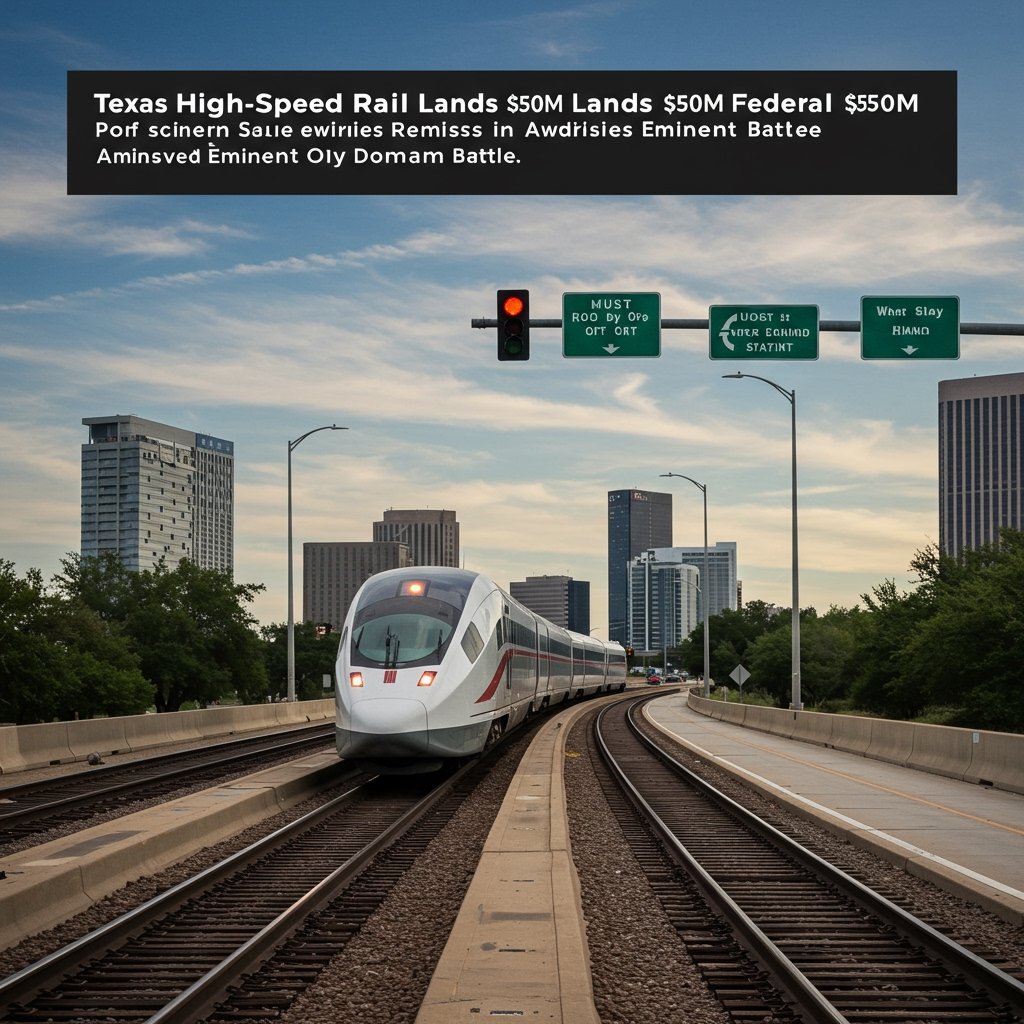Federal Funding Arrives as Legal Challenges Mount
The ambitious plan to connect Dallas and Houston via a high-speed rail line received a significant financial injection this week, even as it confronts renewed legal opposition over land acquisition. The Texas High-Speed Rail Corporation announced on Tuesday, May 27, securing a substantial $500 million federal grant sourced from the Bipartisan Infrastructure Law. This critical funding is specifically earmarked for essential pre-construction activities and environmental reviews along the proposed Dallas-Houston route, representing a key step forward for the long-stalled project.
However, this positive development is juxtaposed against the emergence of several new lawsuits challenging the project’s authority to utilize eminent domain for acquiring necessary land. These legal actions have surfaced in Waller and Grimes counties, areas traversed by the planned route where land ownership remains a contentious issue. The dual nature of this week’s news underscores the complex and persistent challenges facing the proposed rail line, highlighting both significant financial progress and entrenched local opposition.
The Boost from Bipartisan Infrastructure Law
The $500 million federal grant represents one of the most significant financial commitments the Texas High-Speed Rail project has received to date. Awarded under the framework of the Bipartisan Infrastructure Law, a sweeping piece of legislation designed to modernize America’s infrastructure, the funding is a clear signal of federal interest in developing high-speed transportation corridors. According to the Texas High-Speed Rail Corporation, this capital is ring-fenced exclusively for advancing critical preliminary work. This includes detailed engineering studies, geological surveys, site analysis, and, importantly, comprehensive environmental reviews. The National Environmental Policy Act (NEPA) review process is often lengthy and complex, requiring thorough assessments of potential environmental impacts and proposed mitigation strategies. Securing dedicated funding for this phase is vital for the project to move past planning stages and towards potential construction. Proponents view this federal investment not just as financial aid, but as a validation of the project’s potential to improve mobility, stimulate economic growth, and offer an alternative transportation option between two of the nation’s largest metropolitan areas. The funding provides necessary resources to complete prerequisites that could ultimately lead to eligibility for future federal aid and private investment.
Project Background and Persistent Hurdles
The concept of a high-speed rail line linking Dallas and Houston has been under consideration for well over a decade. Proposed by the Texas High-Speed Rail Corporation (and associated entities), the project envisions a 240-mile line capable of speeds up to 205 mph, reducing travel time between the two cities to approximately 90 minutes. The initiative is primarily planned as a privately funded endeavor, though it has sought and received some public support, including this recent federal grant. The route largely follows existing utility corridors, aiming to minimize disruption, but necessitates acquiring land from numerous private landowners along the path, particularly in rural areas between the urban centers.
From its inception, the project has faced significant opposition from a coalition of landowners, local officials, and community groups concerned about property rights, rural impacts, and the use of eminent domain. Legal battles over the project’s classification as a railroad with the power of eminent domain have wound their way through Texas courts for years. While some key rulings have favored the project’s proponents in the past, establishing their legal right to condemn land, the resistance has remained steadfast, often manifesting in ongoing legal challenges and public advocacy against the project.
Escalating Eminent Domain Controversy
Despite previous legal victories for the project regarding its eminent domain authority, new challenges are actively being pursued by landowners in Waller and Grimes counties. These fresh lawsuits typically argue that the private corporation does not qualify as a common carrier railroad under Texas law, and therefore lacks the constitutional or statutory power to force the sale of private property through eminent domain. Landowners express deep concerns over being compelled to give up ancestral lands or properties critical to their livelihoods for a project they view as a private venture that does not serve a broad public use in the traditional sense that justifies eminent domain powers.
These new legal filings represent the latest front in a protracted battle over property rights. Landowners, often represented by specialized legal counsel and supported by local advocacy groups, are utilizing various legal strategies to challenge the project’s right-of-way acquisition process. The suits question not only the fundamental right to condemn but also potentially the procedures and valuations involved. The re-emergence of these legal disputes in key counties highlights the continued, potent opposition at the local level, acting as a significant non-financial hurdle alongside the technical and environmental reviews now being funded.
Legal Landscape and Expert Analysis
The legal landscape surrounding the Texas High-Speed Rail project’s use of eminent domain is complex and has seen varied court interpretations over time. While the Texas Supreme Court has issued rulings that project proponents have interpreted as affirming their eminent domain authority, the door for individual or localized challenges appears to remain open, particularly regarding the specifics of the project’s status and impact. The new lawsuits in Waller and Grimes counties are expected to delve into these nuances, potentially presenting new arguments or seeking different interpretations of existing law or facts specific to those localities.
According to legal experts, the filing of these new lawsuits, regardless of their eventual outcome, introduces significant uncertainty and is highly likely to cause further delays for the project. Litigation, especially complex cases involving property rights and constitutional questions, can take months or even years to resolve through trial and potential appeals. These delays can, in turn, lead to increased project costs, as planning and development teams face extended timelines, inflation impacts on future construction, and ongoing legal expenses. Experts suggest that while the $500 million federal grant is a substantial boost for preliminary work, the unresolved legal challenges surrounding land acquisition remain a fundamental obstacle that could impede the project’s progress towards actual construction, regardless of funding availability for early-stage activities.
Path Forward and Uncertainties
The Texas High-Speed Rail Corporation now faces the dual task of effectively utilizing the $500 million federal grant to conduct thorough pre-construction activities and environmental reviews while simultaneously navigating the renewed legal challenges in counties like Waller and Grimes. The funding allows for essential technical and environmental work to proceed, which is necessary regardless of the land acquisition method, but the outcome of the eminent domain lawsuits will ultimately determine the project’s ability to secure the necessary right-of-way to build the line. Project proponents will likely seek swift resolutions to these legal matters, possibly through negotiation or vigorous defense in court.
However, opponents remain resolute, committed to protecting private property rights through legal means. The interplay between the federally funded technical progress and the locally driven legal battles will define the project’s trajectory in the coming months and years. While the grant provides a clear path forward for initial development steps, the shadow of eminent domain litigation introduces considerable uncertainty regarding timelines and overall feasibility. The project’s future hinges on successfully completing the environmental and engineering prerequisites and overcoming the persistent legal hurdles to land acquisition along the Dallas-Houston route.






